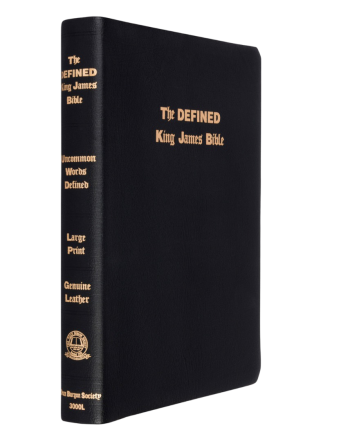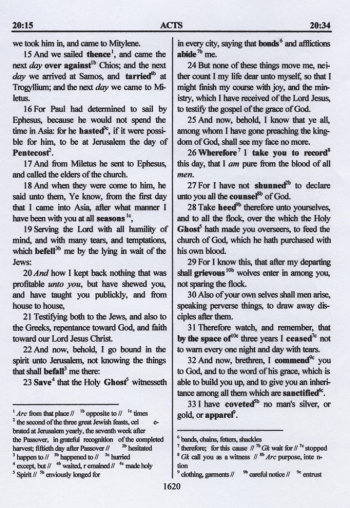Yes. I agree. Scourby is really awesome.
I have to talk more to a friend to get the other ones I heard that are good, too.
===================================================================================
He should have never put it in there!
The King James Version (KJV) was originally published, in 1611, by the royal
printer, Robert Barker. In the margins of that very first edition, there
were some 8,422 notes. Several of these notes indicate that a particular
verse itself may not be exactly correct.
For example, here is Luke 17:36 as it appears in the New King James Version
“Two men will be in the field: the one will be taken and the other left.”
Here is the note that appeared in the margin of that original 1611 edition:
“This 36. verse is wanting in most of the Greek copies.”
If you have a NIV, don’t bother looking this verse up. It is not in that
Translation. What the note said in essence was, “we have reason to believe that this verse should not be in here at all.”
Well, therein lies Textual Criticism, which is the study of what the
Original Autographs (these are the actual writings of the Apostles
themselves) exactly contained. In other words, before we can know what the
Bible says, we need to know what the Bible is. And this is no small task.
Once a group of Textual Critics finish their work, they turn their work over
to the printers to publish. That way, we can read the Bible.
In this article, I would like to draw our attention to some amusing mistakes
that found their way into the KJV. Fortunately, they have all been fixed
with subsequent Editions. Bear in mind, the King James Version went through
many revisions, including one the very next year in 1612. And again in 1613.
And many more after that.
Oddly enough, the KJV was translated from only about six Greek manuscripts
dating no earlier than the 10th century. Although there are more than 5,400
Greek manuscripts today, back in the 1600’s that was not the case.
The relatively few Greek manuscripts that are behind this KJV date between
the 10th and 14th centuries. Since the publishing of the first KJV, more
than 2,000 Greek manuscripts have been found. And some of these date back as
early as the 2nd century. (Remember, the earliest Greek manuscript
supporting the KJV is 800 years later.) With the new discovery of older
manuscripts, modern versions have come on the scene. The NIV is based on
different Greek manuscripts than is the KJV. That is why they differ at
places, as noted above.
Here is one example as to why they differ. When a man by the name of Erasmus
was putting together the Greek New Testament in the early 1500’s, he could
find no existing Greek manuscript that contained the words in 1 John 5:7,
which reads in the KJV, “For there are three that bear record in heaven; the
Father, the Word, and the Holy Spirit: and these three are one.” It’s in the
KJV even to this day, but Erasmus refused to put it in his Greek Edition,
unless…
That was his mistake! Erasmus went on public record saying that if anyone
could produce even one Greek manuscript with the disputed passage in it, he
would put it in his next Greek Edition. (These disputed words were first
noticed in a not-so-old Latin version.) Erasmus’ first two Greek New
Testaments did not contain this passage.
Well, along comes an enemy of Erasmus, by the name of Edward Lee, and he
mysteriously produces a Greek manuscript (a very highly suspect one, I might
add) that contained these words. So, Erasmus, true to his word, yet being
convinced it would not do too much damage to sacred Scripture, unwillingly,
put it in his third Edition. Erasmus did note that he doubted its
authenticity. Right here is where my opening line fits in. He was true to
his word, but not the Word of God.
Well, no early Greek manuscript has this passage in it. Not one early
manuscript! No Greek manuscript dated in the first 5 centuries has this
passage in it. So, if we look at most modern versions, we simply will not
find that passage in it. There are a lot of these types of disputes in the
various manuscripts, practically all of them very insignificant. So, one set of Greek manuscripts read one way and another set of manuscripts say something slightly different, and that’s why we have different versions today.
These differences in Greek manuscripts are actually to be expected. Let’s
suppose, for example, you asked 100 people to copy the book, Moby Dick. Do
you think any two would be exactly alike? Of course not! And if we took the
original book away, and then tried to recreate it, using only the 100
copies, how close to the original Moby Dick do you think we could get? Real
close! If on page 28, I wrote Moby Dock, and my brother, Tiger, wrote Muby
Dick, and 98 other people wrote Moby Dick, would you consider my wording
(Dock) or my brother’s wording (Muby) correct? There is your answer to the
Greek manuscripts. The variants are about as tough to work through as this
preceding example. (In fact, I know my brother well enough to also say the
he will misspell “receive” every time. He puts the i before the e. And
remember, every time that “receive” is misspelled, that’s another variant, even though it’s the same variant each time. If, for example each time misspelled is observed, that’s 48 times, that’s 48 variants. As you can see, they add up pretty quickly.)
Let me show you why some people are initially shocked when they begin their
study of Textual Criticism. The Greek New Testament has roughly 138,162
words. Taking all the 5,800 Greek manuscripts together, there are somewhere
between 400,000 and 500,000 variations. That’s about 3+ variants PER WORD!
Maybe this will help. Let me give you a couple of those variants in one
small phrase in the Bible:
In John 4:1 some manuscripts read, “Then when Jesus knew.” Some other
manuscripts read, “Then when the Lord knew.” One manuscript has, “Then when
Jecus knew.” So, some say “Jesus” and some say “the Lord” and one misspelled
“Jesus.” (There are actually a few more that misspell “Jesus”)
So, how many variants do you see? Are you concerned with any of them? Here’s
the good news: That is just about the extent of the vast majority of
variants in the New Testament. As you can see, not knowing the history of the Bible makes us vulnerable to every wind of doctrine, or false claims against the Word. But when we add up all the ‘discrepancies’ and ‘variants’ there is absolutely nothing to be concerned with. Absolutely nothing! The preservation of the Word of God over the years, one could argue, has a supernatural element to it.
I mentioned earlier that since the first publication of the KJV of 1611, of
which there have literally been thousands of corrections to it, many Greek
Manuscripts have been discovered. How one or two of those manuscripts were
discovered are interesting stories.
More than 200 years after the first KJV, in the Spring of 1844, a man by the
name Count Konstantin von Tischendorf, a man (genius) fluent in classical
languages and dialects, took a trip to Mount Sinai to visit a monastery. He
took this trip in hopes of discovering ancient biblical documents. The
monastery he visited was called St. Catherine’s, then occupied by Russian
monks. Initially, he was a bit disappointed when he was unable to find what
he was looking for. However, as he looked in a small room near the Library,
he noticed something very unusual in the trash can, of all places! His heart
began to race as he approached this waste basket. The contents, sheets of
‘paper’ written on animal skin, seemed all too familiar to him. He was well
aware that ancient documents were written on the very kind of “trash” he was
looking at. Well learned in Koine Greek, he picked up a sheet and began
reading it. It was the Old Testament! As he kept digging deeper, the New
Testament was also there. There were 129 pages of the oldest known
recordings of the Bible, written almost 1,500 years earlier. Who knows how
many pages had already been burned to warm those Russian monks.
Con't



